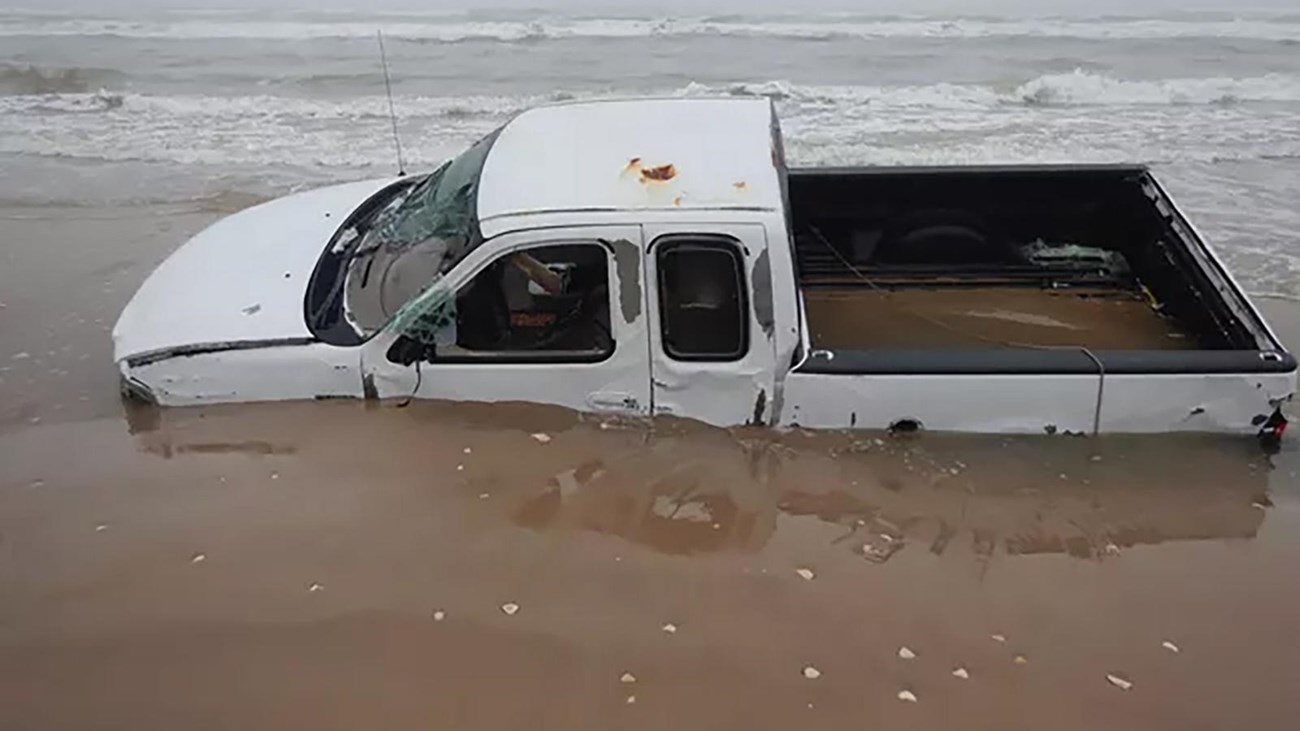Last updated: April 24, 2025
Thing to Do
Driving Down Island

NPS / Charles Sassine
One of the most popular activities to do when visiting the national seashore is to drive on the beach and travel down island. Venturing beyond the pavement can get you to some of the most remote areas of the park, awarding you the experience of solitude in this natural landscape. Popular areas of the park such as Little Shell Beach, Big Shell Beach, Yarborough Pass, and Mansfield Channel can only be reached by driving along the wild coastline of Padre Island.
Be Prepared
Before making a trip out to the park to drive on the beach down island, it is important to plan ahead and prepare. Doing the necessary preparation before your trip will ensure you have an enjoyable one.
- Check to see if there are any active alerts in the park.
- Look at the weather forecast and predicted tides.
- Examine your vehicle and supplies to make sure you have everything you need to be self-sufficient in case a problem arises.
- Be aware of general park safety information.
- Tell a family member or friend your plan before you enter the park. Cell phone service is unreliable in the park, and you may not be able to check-in with family or friends when you are down island.
If you have an emergency, dial 911 or notify any park ranger. You may need to climb a dune to get cell phone service.
Choosing the Right Vehicle for Driving on the Beach
The beach and driving conditions can change quickly depending on the weather, tides, and location. If you are planning on driving on the beach and traveling down island, come prepared with an appropriate vehicle and vehicle drive type.
Texas beaches are public highways and all traffic laws apply, including seat belt regulations. All vehicles operating in the park must have a valid state or government-issued vehicle registration and license plate issued for public highway travel. The Texas OHV (Off-Highway Vehicle) license plate does not meet this standard. Unregistered OHVs, including but not limited to ATVs, UTVs, golf carts, dune buggies, sand rails, amphibious vehicles, and any other non-highway vehicles, are prohibited from being operated in the park.
Towing
The park does not tow non-government vehicles. Be aware that the cost for a private tow company to come down island can be several hundred to several thousand dollars.
Rules & Regulations for Traveling Down Island
When conditions allow, driving is permitted on North and South Beach. Traveling on the beaches beyond the paved road is done so at your own risk. Your safety is your responsibility. Four-wheel drive vehicles are recommended.
- Protect the Dunes. Do not drive behind the dunes, over areas of beach covered in vegetation, on tidal flats or wetlands.
- Right of Way. Northbound traffic has the right of way. Watch for pedestrians.
- Do Not Block Traffic. Keep the main driving lane clear when parking or camping on the beach.
Speed Limits
Mile marker-0 to MM-2.5:
- 15 MPH year-round.
MM-2.5 to MM-60:
- 25 MPH, day after Labor Day through the end of February.
- 15 MPH, March 1 to Labor Day.
Sea Turtle Nesting Season
During the sea turtle nesting season (April to August), be alert for nesting sea turtles crawling across the beach during the day and night. If you see a sea turtle on the beach, do not disturb it. Mark the area and report the sighting to the nearest park ranger as soon as possible.
Call (24-hours) to the Texas Sea Turtle Stranding and Salvage Network at 1-866-TURTLE-5 (1-866-887-8535).
- Pets must be leashed (up to 6 feet) at all times.
- Leashed pets are allowed on park beaches, campgrounds, trails, and boardwalks.
- Disruptive or aggressive pets should not be taken into the following areas due to the presence of other visitors:
- Malaquite Visitor Center deck and boardwalk.
- The short stretch of beach directly in front of the visitor center.
Obstacles and Hazards
Obstacles and hazards can be present on the beach and roadway. Follow the posted speed limits and be aware of your surroundings.Trees and other large debris can be washed onto the beach by high tides.
Large barrels washed onto the beach may contain hazardous waste.
Tides and currents in the gulf can create sharp drop-offs on the beach.
Sharp objects (e.g. nails, fish spines, medical waste) may be on the beach.
Sea turtles and other wildlife may be found on the beach and in the roadway.
Children and other visitors may run into the roadway from parked vehicles or campsites on the beach.
